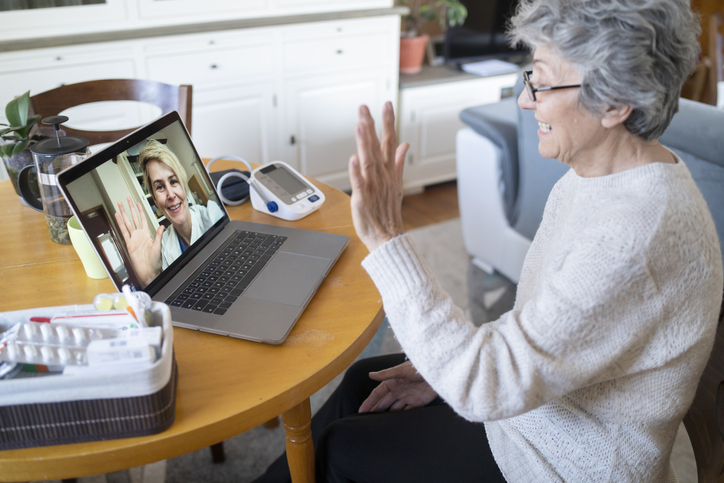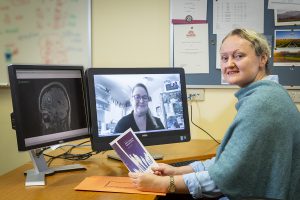
Every day in Australia, six people are diagnosed with a brain tumour and four will die, making services to enhance quality of life for individuals and their families imperative.
Two Griffith University-led research studies reveal the positive impact of the telehealth Making Sense of Brain Tumour (Tele-MAST) initiative and illustrates the 10-session videoconferencing program decreases depression and anxiety and has potential to ease the financial burden to the healthcare system.
Following 16 years of development, the Tele-MAST program aimed at improving quality of survivorship and psychological wellbeing, is now rolling out nationally.

Clinical neuropsychologist with the Griffith School of Applied Psychology and Research Director of The Hopkins Centre, Menzies Health Institute of Queensland (MHIQ), Professor Tamara Ownsworth said individuals with brain tumour experienced diverse side effects such as epilepsy, severe fatigue, nausea, confusion, and distress which could lead to social isolation and depression.
“We found participants who received the Tele-MAST program were four times more likely to become less depressed and also reported significantly reduced anxiety and increased quality of life compared to people receiving standard care (telephone-based counselling),” Professor Ownsworth said.
“As part of this study, we evaluated the cost-effectiveness or ‘value for money’ of the telehealth intervention by comparing the inputs and outputs of the intervention with standard care.
“We did this by collecting data on the resources used to deliver the intervention together with uptake of psychological service use and observed the improvements in participants’ wellbeing.

According to health economist Professor Louisa Gordon of the QIMR Berghofer Medical Research Institute, who conducted the health economic analysis, the intervention was not only effective but represented a good investment for health services.
“Overall, the Tele-MAST intervention was found to be a cost-effective intervention for improving the mental health of people with brain tumour in Australia,” Professor Gordon said.
Professor Ownsworth said past research on adjustment to brain tumour found psychological support needs are often overlooked during and after treatment.
“Being diagnosed with and treated for a brain tumour can be a highly stressful experience and many people find it difficult to understand their illness and feel uncertain and worried about the future,” Professor Ownsworth said.
“Studies are usually focused on understanding the illness at a cellular level, such as laboratory-based studies which aim to determine how to stop the progression of the tumour.”
Griffith Master of Global Health student, Disability and Inclusion Advocate and Ambassador Julia Robertson was diagnosed with a brain tumour in 2003.

Ms Robertson designed a resource during her Community Internship which helped patients to understand how to use Zoom and this became a valuable resource for the Tele-MAST program.
She said like so many, her diagnosis was an overwhelming rollercoaster which made her feel isolated.
“Among many other symptoms, I had severe memory loss,” Ms Robertson said.
“I’d forgotten how to do basic math and I had to retrain my brain to learn and remember things.
“I decided I wanted to help make the lives of people living with a brain tumour a little easier.
Ms Robertson received a brain tumour diagnosis in 2003, in 2011 she suffered a stroke and had brain surgery, in 2012 she enrolled at TAFE, then started studying a Bachelor of Science at Griffith University in 2014 and switched to a Bachelor of Psychological Science in 2016.
“I am a stubborn person and I felt so determined that I would retrain my memory and begin studying,” Ms Robertson said.
“I completed my Bachelor of Psychological Science in 2019 at Griffith’s School of Applied Psychology then began my Master of Global Public Health in 2020 at the School of Medicine so I would be better armed to help others navigate the unique space that is life with a brain tumour.”
The extraordinary research journey leading to the National rollout of Tele-MAST:
2006 – 2009: The Pilot research in partnership with Cancer Council Queensland identified two overarching unmet support needs for people with brain tumour: Access to timely information about brain tumours and psychoeducation, and a need for counselling and psychological support for individuals and their family caregivers.
2010 – 2013: Making Sense of Brain Tumour (MAST) intervention was delivered to 50 participants, in-person and in-home. The study was the first randomised controlled study evaluating the benefits of psychological support for the brain tumour population. The program was found to result in reduced symptoms of depression and increased quality of life compared to usual care (wait list control). This first MAST intervention was funded by the Cancer Council Queensland through a bequest to support initiatives that contribute to quality of survivorship.
2014 – 2015: Telephone-based MAST was initiated to overcome issues related to access because the program could only be delivered to people living in the Brisbane metropolitan area. This proof-of-concept study showed that remote delivery of MAST was feasible and acceptable to people with brain tumour, although the lack of visual communication cues (e.g., seeing the therapist’s face) was a barrier for some participants.
2017 – 2019: Feasibility study of a video conferencing format of the MAST program was funded by the Metro South Health Research Support Scheme, and found that people valued the sense of connection they got from seeing the therapist face-to-face.
2018 – 2022: Clinical efficacy and cost-effectiveness trial of the Tele-MAST program was a randomised controlled trial and NHMRC Partnership Project involving 82 people with a brain tumour. This collaborative project between Griffith University, Cancer Council Queensland and Metro South Health found, compared to standard care (telephone-based counselling), participants receiving the Tele-MAST program showed significantly reduced depression and anxiety and improved quality of life.
The findings were published in the journal Psycho-Oncology: Evaluation of the telehealth making sense of brain tumor psychological support intervention for people with primary brain tumor and their caregivers: A randomized controlled trial
2021-2023: MRFF Brains Program – The national rollout of Tele-MAST offers everyone in Australia the opportunity to take part in the intervention until late 2023. Funded by the Australian Brain Cancer Mission, the BRAINS program is focused on developing and implementing psychosocial care interventions for adults with brain cancer and their family members. Tele-MAST is one of several interventions being evaluated as part of a broader national initiative led by the University of Sydney.






